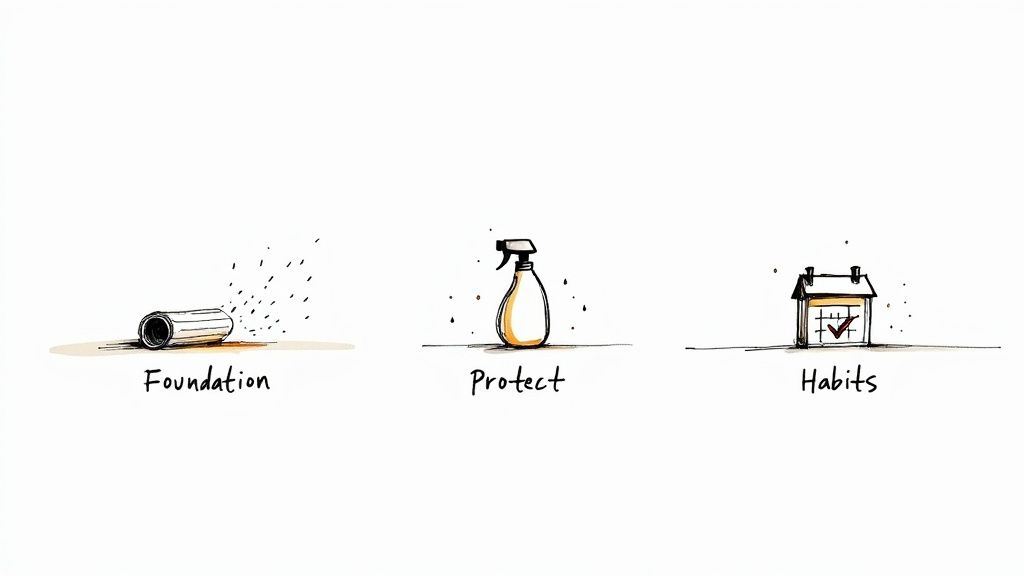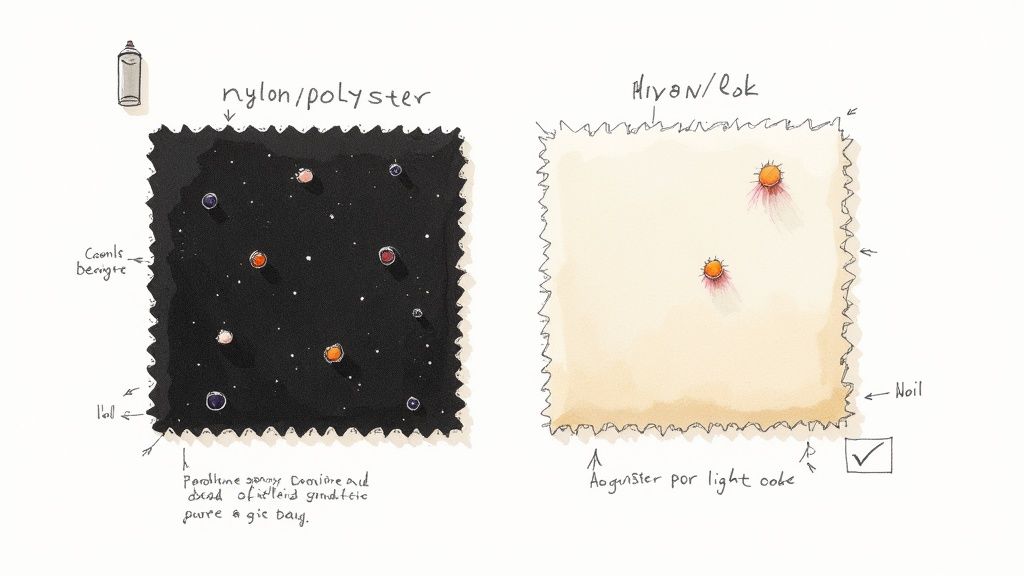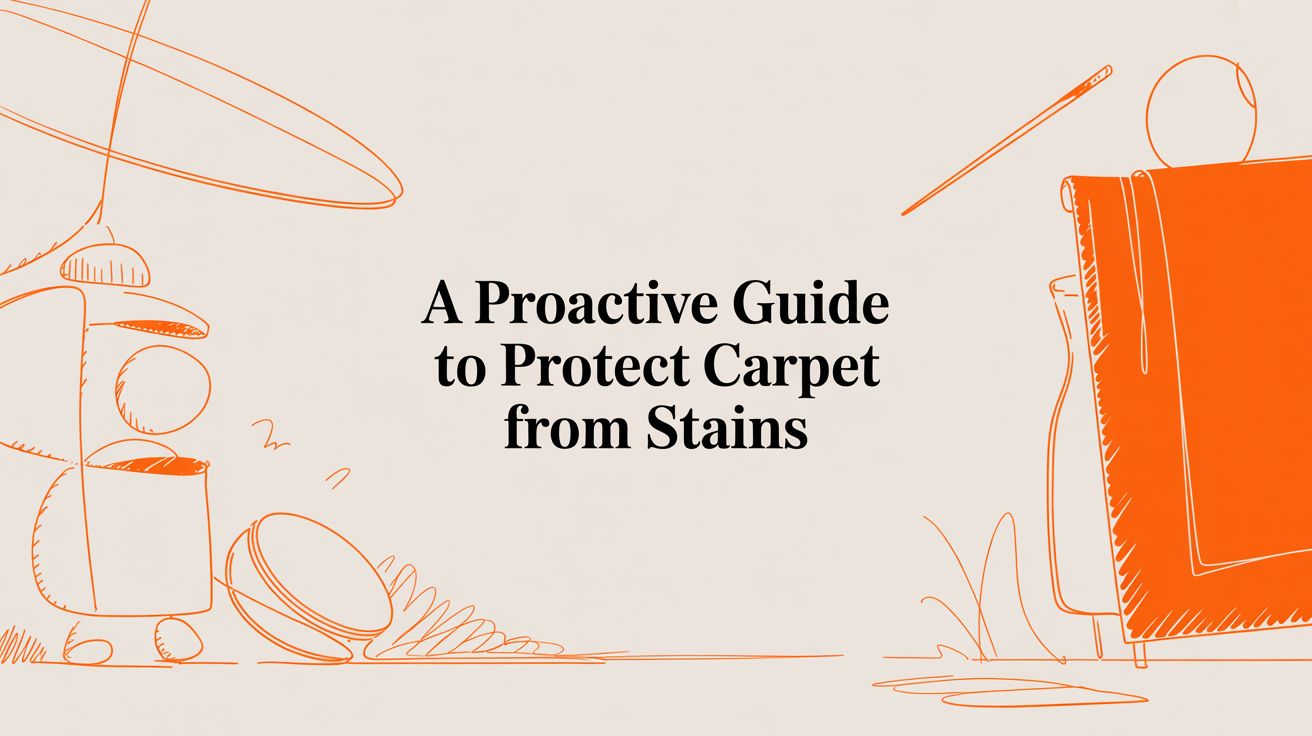Keeping your carpets looking brand new isn’t about frantically scrubbing spills the moment they happen. It's about having a smart, proactive game plan to protect carpet from stains before they even get a chance to set. This guide is all about shifting your mindset from that reactive panic to preventative measures that truly make a difference. We'll walk through a simple philosophy built on smart choices, effective treatments, and practical household habits.
A New Philosophy For Carpet Protection

Here’s the secret: protecting your carpet is an ongoing process, not a one-and-done deal. It’s about building layers of defense that work together to keep your floors looking pristine.
Think of it less like an emergency response team rushing to a disaster and more like a long-term wellness plan for your home's flooring. The goal is simple: minimize the opportunities for stains to happen in the first place, while being fully prepared for when they inevitably do.
This approach saves you a ton of time, stress, and money in the long run by extending the life and beauty of your carpet. Let's be honest, flooring is a major investment for both homeowners and businesses. The global carpet market was valued at $58.93 billion and is only projected to grow, which tells you just how much we value these assets. It's no surprise the demand for products to protect them is rising, too. You can learn more about carpet market trends and what's driving this growth.
Proactive vs. Reactive Strategies
The first step is understanding the huge difference between being proactive and being reactive. One is about prevention, the other is just damage control.
- Proactive Measures: These are the smart things you do before a spill happens. We're talking about applying stain repellents, putting down high-quality doormats, and maybe even establishing a "no shoes in the house" rule.
- Reactive Measures: This is the frantic cleanup after the glass of red wine has already tipped over. While it's obviously necessary, relying only on reactive cleaning is a recipe for set-in stains and a whole lot of frustration.
The most effective way to protect your carpet from stains is to build a defense so strong that most potential disasters never even become a threat. For your floors, a good offense is truly the best defense.
This guide will help you shift from constantly cleaning stains to preventing them almost entirely. To kick things off, the table below gives a quick comparison of these two approaches. It really sets the stage for the specific strategies we're about to dive into.
Proactive vs Reactive Carpet Protection Strategies
Here's a quick look at how preventative measures stack up against emergency clean-up tactics for managing carpet stains.
| Strategy Type | Method | Effectiveness | Best For |
|---|---|---|---|
| Proactive | Carpet protectors, regular vacuuming, area rugs | High. Prevents stains from ever setting in. | Long-term carpet health and minimizing cleaning emergencies. |
| Reactive | Spot cleaners, blotting, emergency cleaning kits | Variable. Depends on the spill and response time. | Immediate accidents and spills that get past your initial defenses. |
As you can see, putting in the effort upfront with proactive strategies makes life a lot easier down the road. While you'll always need a good spot cleaner on hand, focusing on prevention is the key to keeping your carpet in top shape.
Choosing the Right Carpet and Protectants

Your best defense against stains starts way before a spill ever happens. It begins the moment you choose your carpet. The material you put under your feet plays a massive role in how well it will fend off life's messes over the years.
When it comes to stain-fighting power, synthetic fibers are the champs. Carpets made from materials like nylon and polyester have fibers that are non-porous. In plain English, that means they don't soak up liquids easily, giving you a crucial window of time to clean up spills before they set in. Natural fibers like wool feel amazing, but they're much more absorbent and will stain in a heartbeat without the right treatment.
Built-In Protection vs. Aftermarket Sprays
Lots of modern carpets come with stain protection applied right at the factory, which is a fantastic head start. That treatment is bonded professionally to the fibers and is built to last. But it’s not invincible—it wears down over time, especially where you walk the most.
That's where aftermarket sprays come into the picture.
- Manufacturer Treatment: This gives you an excellent baseline of protection that can hold up for several years.
- Aftermarket Sprays (like Scotchgard): These are perfect for reviving worn-out protection or for giving a boost to carpets that never had a factory coating to begin with.
Applying a protectant yourself is a simple way to beef up your carpet's defenses. Just make sure you're in a well-ventilated space, spray in overlapping sections so you don't miss any spots, and let it fully cure—usually for about 24 hours—before anyone walks on it.
The "right" carpet really depends on the room. A low-pile, darker synthetic carpet is a no-brainer for a chaotic family room, while you might get away with a beautiful wool rug in a quiet, low-traffic bedroom.
Making Practical Choices for Your Home
Take a hard look at your lifestyle. If you've got kids or pets, picking the best carpet for pet owners is less of a luxury and more of a necessity. You'll want to prioritize durability and serious stain resistance. A dense, tightly woven carpet also does a better job of keeping dirt on the surface, making your vacuuming way more effective.
Ultimately, putting some thought into your carpet material and its protective treatment lays the foundation for a stain-resistant home. It's truly the most important proactive step you can take.
When it comes to keeping carpets clean, the best defense is a good offense. It's really all about weaving smart habits into your daily life. Forget about frantically trying to clean up spills after they happen—setting a few practical ground rules for the house is a million times more effective.
This goes way beyond the classic “no shoes inside” rule, though that’s a great start. Think about where the biggest risks come from. I always advise clients to create "safe zones" for the messiest stuff. That glass of red wine? The kid's bowl of spaghetti? Keep them strictly in the kitchen or dining room where the floors can handle a spill.
Setting Clear Boundaries for Kids and Pets
If you have kids or four-legged family members, you know that managing a little chaos is part of the deal. Designate a specific spot for messy arts and crafts—a room with tile or hardwood is perfect. This simple move prevents a fun afternoon with paint and glue from becoming a permanent, multi-colored stain on your living room floor.
For pets, a waterproof mat under their food and water bowls is a non-negotiable. It's a small change, but it stops those constant splashes and drips from seeping into your carpet fibers, which can lead to nasty smells and even mold over time.
Here's a good rule of thumb I've picked up over the years: Treat your carpeted areas like a “no-fly zone” for the biggest stain culprits. Once you shift your mindset, protecting your carpet becomes an automatic habit, not a chore.
And let's not forget the dirt they track in from outside. If you have a dog who loves to dig, learning how to stop your dog digging in the garden can save your carpets from a world of muddy paw prints. It's one of the most common sources of stains I see.
Another game-changer that people often underestimate is a high-quality doormat system at every single entrance. It sounds so simple, but a good setup can trap up to 85% of dirt and moisture before it even has a chance to get on your carpet.
- Scraper Mats Outside: These are the tough, coarse mats that knock the heavy mud and grit off the bottom of shoes.
- Wiper Mats Inside: Place these absorbent mats right inside the door to catch the finer dust and any leftover moisture.
When you combine these simple rules and tools, you're not just cleaning—you're building a powerful, multi-layered defense system. It’s how you keep your carpets looking great for the long haul with way less effort.
Assembling Your Essential Stain Prevention Toolkit
When a glass of red wine tips over, the last thing you want to do is scramble through cabinets looking for the right supplies. That moment of panic can be the difference between a minor cleanup and a permanent eyesore. Being prepared with a dedicated, well-stocked toolkit is probably the most underrated part of protecting your carpet.
It’s all about having a few key items ready to go. You don't need a whole aisle of cleaning products; you just need the right ones for the job. There's a reason the market for carpet spot removers is projected to grow from $1.3 billion in 2025 to $2.1 billion by 2035—life happens. Spills are a universal problem for homeowners.
Your toolkit should be simple but powerful.
Core Cleaning Supplies
Let's start with the non-negotiables. These are the items you'll reach for 90% of the time, so keep them together in a small caddy or bucket.
- White Absorbent Cloths: The keyword here is white. Using colored rags can cause dye to bleed into your carpet, creating a second, even worse stain. Stick with plain white towels or paper towels.
- Dull Knife or Scraper: Absolutely essential for tackling goopy messes like mud, dropped food, or anything solid. It allows you to lift the excess off the carpet fibers instead of accidentally pushing it deeper.
- Spray Bottle: Grab a simple spray bottle and fill it with a 50/50 mix of plain white vinegar and water. This classic DIY solution is a fantastic first response for many everyday, non-greasy spots.
A well-organized toolkit turns panic into a calm, methodical response. When you know exactly what to grab, you save precious seconds that can make the difference between a temporary spill and a lasting stain.
For those looking into newer, gentle cleaning technologies, it's worth exploring the benefits of hypochlorous acid cleaning sprays for how effectively they can tackle stains.
This infographic is a great reminder of the simplest prevention strategy of all: location, location, location.

Sometimes the best way to protect your carpet is just to keep messy projects and meals over tile or hardwood from the start.
Finally, for those tough organic stains—I'm talking pet accidents, blood, or that spilled smoothie—you need something with a little more muscle. An enzymatic cleaner is your best friend here. If you're not sure how they work, you can learn more about what an enzymatic cleaner is and see why their protein-eating enzymes are so good at completely breaking down those stubborn, smelly messes.
Emergency Stain Response Cheat Sheet
Knowing what to do is half the battle, but knowing what to grab is just as important. Think of this table as your quick-glance guide for matching the spill to the right tool in your kit.
| Type of Stain | First Action (Tool) | Recommended Cleaner | Pro Tip |
|---|---|---|---|
| Wine or Juice | Blot with a white cloth | White vinegar & water solution | Blot, don't scrub! You want to lift the stain up, not rub it in. |
| Mud or Dirt | Let it dry, then scrape & vacuum | Water or mild spot remover | Trying to clean wet mud will just create a bigger, smeared mess. |
| Grease or Oil | Scrape excess, apply baking soda | Dish soap & water (sparingly) | The baking soda helps absorb the oil before you start cleaning. |
| Pet Urine | Blot heavily with a white cloth | Enzymatic cleaner | Enzymes are critical here to break down the proteins that cause odor. |
When a spill happens, take a deep breath, identify the culprit on this chart, and grab the corresponding supplies. A calm, correct response is your best defense against lasting carpet damage.
Mastering Long-Term Carpet Care and Maintenance
If you really want to protect your carpet from stains, you have to think of it as a long game—a marathon, not a sprint. The absolute bedrock of any long-term strategy is simply good, old-fashioned, consistent vacuuming.
I'm not just talking about a quick pass to make things look tidy. It's about getting deep into the fibers to pull out all those tiny, abrasive dirt particles. Think of them like microscopic bits of sandpaper. Every time you walk on the carpet, those particles grind away at the fibers, weakening them and making them a prime target for future stains.
For most homes I see, hitting the high-traffic spots at least twice a week is a must. Anything less, and you're letting that gradual damage build up.
Why Professional Deep Cleaning Is a Game-Changer
Your vacuum is your day-to-day workhorse, but you also need to call in the cavalry every so often. No matter how good your vacuum is, it simply can't reach the deep-set grime, oils, and allergens that eventually settle at the base of your carpet.
This is where a professional cleaning makes all the difference. It's not just about getting the carpet clean; it's also about refreshing the protective treatments on the fibers that your manufacturer applied. That’s a big reason why our guide on how often you should clean your carpet recommends a professional deep clean every 12-18 months. It's the key to making your carpet last.
I tell my clients to think of a professional deep cleaning as a "factory reset" for their carpet's defenses. It clears out all the accumulated gunk that daily cleaning can't touch and restores its ability to fight off new spills and dirt.
This kind of ongoing care is so critical that the carpet stain remover industry is enormous. Seriously, it's projected to hit $2.5 billion by 2025, all driven by people wanting effective ways to keep their homes clean. You can see more on the growth of the carpet care market and what that trend means.
Ultimately, it’s the one-two punch that works. Your diligent vacuuming, combined with periodic professional care, creates a powerful defense system that will keep your investment looking fresh for years.
Of course, even with the best game plan, you're going to have questions when it comes to keeping your carpet spotless. I get them all the time. Getting straight answers can make a huge difference in how well your carpet holds up over the years.
Let's tackle a few of the most common ones I hear.
How Often Should I Reapply Protector Spray?
This is a great question. For most of the protector sprays you can buy at the store, you should probably plan on putting down a fresh coat every 6 to 12 months.
But here’s the real pro tip: the absolute most important time to reapply is right after a professional deep cleaning. That hot water extraction process is fantastic for yanking out deep-down grime, but it can also strip away the protective layer you had on there.
Are Stain-Resistant Carpets Actually Stain-Proof?
This is a big one. It's crucial to know that "stain-resistant" and "stain-proof" are two very different things. Honestly, no carpet is completely bulletproof.
Stain-resistant carpets are made with fibers that have been chemically treated to help repel liquids. This gives you a massive advantage—a bigger window of opportunity to clean up a spill before it has a chance to soak in and become permanent. But let's be real, harsh stuff like red wine, coffee, or anything with strong artificial dyes can still leave their mark if you don't act fast.
Think of "stain-resistant" as a helpful time buffer, not a suit of armor. Quick action is still your best defense against a lasting mark.
Can I Use DIY Cleaners Like Vinegar?
I'm a fan of DIY solutions when they're used correctly, but they are definitely not a one-size-fits-all fix. For most synthetic carpets like nylon or polyester, a simple mix of white vinegar and water is usually safe and pretty effective.
Where you get into trouble is with natural fibers. If you use an acidic cleaner like vinegar on a wool or silk rug, you can cause serious, irreversible damage. The golden rule is simple: always test any cleaner, homemade or store-bought, on a small, hidden spot first. Find a spot in a closet or under the sofa before you go after the stain in the middle of the room.
Ready to let a pro handle that deep-set dirt and bring back your carpet's protective barrier? The team at Citrus Carpet Cleaning Buford uses an expert, low-moisture cleaning method that leaves your floors fresh, clean, and totally residue-free. Schedule your "EXACT-imate" today at https://citruscarpetcleaningatlanta.com.

